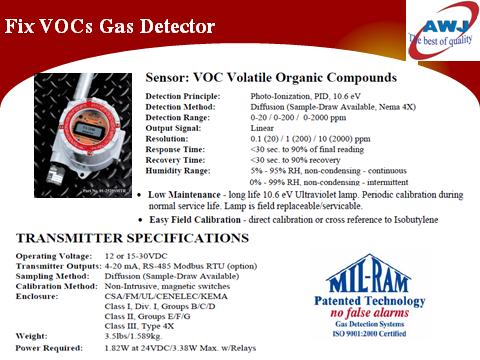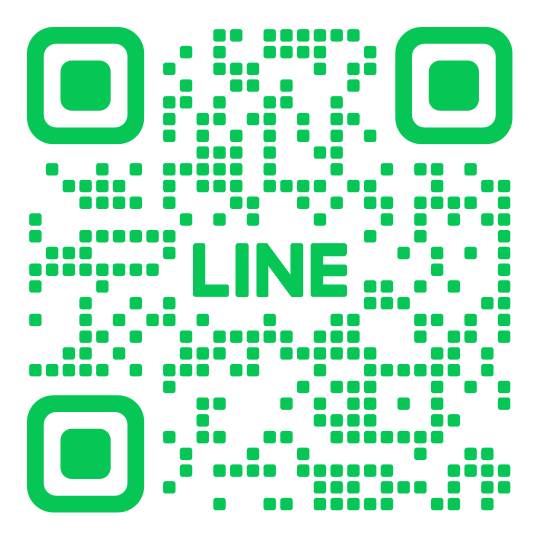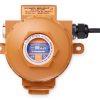Portable VOC Detector Gas-Pro PID
ใช้เทคโนโลยี Photo Ionization Detector เพื่อให้คุณสามารถ ตรวจสอบ VOC ได้หลายร้อยชนิด • Top Display ทำให้อ่านค่าได้ทันทีเพียงก้มมอง • สามารถใส่เซ็นเซอร์ VOC ร่วมกับ เซ็นเซอร์วัดก๊าซอื่นเช่น CH4, O2,CO,H2S ได้รวมสูงสุด 5 ก๊าซ • สามารถเลือกวัดเป็น Total VOC (TVOC) หรือระบุเป็นสาร VOC เฉพาะก๊าซชนิดนั้นๆได้ • ดูสัญญาณแสงได้รอบทิศทาง พร้อมเทคโนโลยี VE+ LED 3 สี ให้สัญญาณเตือนแบบต่าง • น้ำหนักเบา ทนน้ำและฝุ่น IP65/66
......................................................................................................................................................................................................
Fix VOCs Gas detector
Sensor: VOC Volatile Organic Compounds
Detection Principle: Photo-Ionization, PID, 10.6 eV
Detection Method: Diffusion (Sample-Draw Available, Nema 4X)
Detection Range: 0-20 / 0-200 / 0-2000 ppm
Output Signal: Linear
Resolution: 0.1(20) / 1 (200) /10 (2000) ppm
Response Time: <30 sec. to 90% of final reading
Recovery Time: <30 sec. to 90% recovery
Humidity Range: 5% -95% RH, non-condensing – continuous 0% -99% RH, non-condensing – intermittent
- Low Maintenance- long life 10.6 eV Ultraviolet lamp. Periodic calibration during Normal service life, Lamp is field replaceable serviceable.
- Easy Field Calibration – direct calibration or cross reference to Isobutylene
 
Detecting VOCs with PID – how it works
Having recently shared our video on pellistors and how they work, we thought it would make sense to also post our video about PID (photo-ionisation detection). This is the technology of choice for monitoring exposure to toxic levels of another group of important gases – volatile organic compounds (VOCs).
What are VOCs?
The nature of gas hazards posed by some working environments can be complex and complete protection is not available from a single solution. This week, our guest blogger, Richard, takes a look at VOCs: how they pose a hazard and what we can do to protect against them.
Volatile organic compounds (VOCs) tend to be liquids that readily give off vapor at room temperature, such as solvents and fuels. At high concentrations, these vapors can explode. At extremely low levels, they can be toxic. While the impact of exposure can sometimes be felt immediately, symptoms may not become apparent for months, if not years, later. Chronic illness can result from repeated and extended low-level exposure. Increased awareness of the chronic toxicity of VOCs has led to reduced occupational exposure limits (OEL) and increased requirements for direct measurement.
The most frequently hazardous form of VOC exposure is vapor inhalation. The best way of guarding against this is the use of a personal gas monitor, correctly worn – i.e. as close as reasonably possible to the breathing zone. In this way, it is exposed to the same levels of toxic gas as its wearer, so it can reliably alert them of the present danger.
A number of different toxic and explosive gases could be present in a working environment. A common approach when using personal instruments is to use a multi-sensor instrument capable of simultaneous monitoring for different atmospheric hazards. The information from the different sensors helps interpret what could be a complex mixture of gases.
It is vital that a personal gas monitor is configured correctly for the environment in which it is to be used. Specific sensors are available for the detection of some toxic gases. These should be used where exposure to that specific gas is a realistic possibility. Good examples are carbon dioxide in the carbonated drinks industry; carbon monoxide in the steel industry; and in water treatment, ozone and chlorine. There are sensors available for each of these gases, usually based on electrochemical technology. There are no such specific sensors for many of the VOC gases, however. In this case, different technology must be relied upon.
Photo-ionization detection
Photo-ionization detection technology is generally considered the technology of choice for monitoring exposure to toxic levels of VOCs. The sensors include a lamp as a source of high-energy ultraviolet (UV) light. The lamp encases a noble gas, most commonly krypton, and electrodes. The UV light's energy excites the neutrally charged VOC molecules, so removing an electron.
The amount of energy needed to remove an electron from a VOC molecule is called the ionization potential (IP). The larger the molecule, or the more double or triple bonds the molecule contains, the lower the IP. Thus, in general, the larger the molecule, the easier it is to detect. Furthermore, this technology does not require use of a sinter, which might prevent the gas reaching the sensor. It is also not susceptible to poisoning by chemicals in cleaning products, or silicone.
PID is very sensitive and will respond to many different VOCs. The magnitude of the response is directly proportionate to the concentration of the gas. However, 50ppm of one gas will give a different reading to 50ppm of a different gas. To cope with this, detectors are usually calibrated to isobutylene and then a correction factor is employed to get accurate readings for a target gas. Each gas has a different correction factor. Therefore, the gas must be known for the right correction factor to be applied.
Consequently, pellistor sensors and photo-ionization detectors can be considered complementary technologies for many applications. Pellistors are excellent at monitoring for methane, propane and other common combustible gases at %LEL levels. On the other hand, PID detects large VOC and hydrocarbon molecules that may be virtually undetectable by pellistor sensors, certainly in the parts-per-million range required to alert to toxic levels. Thus, the best approach in many environments is a multi-sensor instrument equipped with both technologies. |






